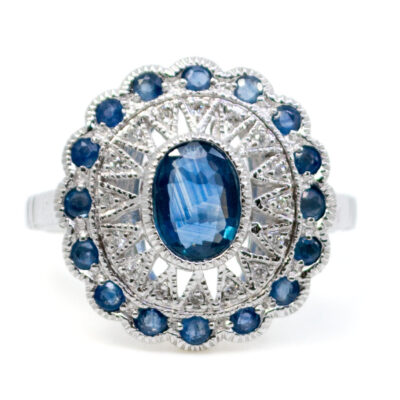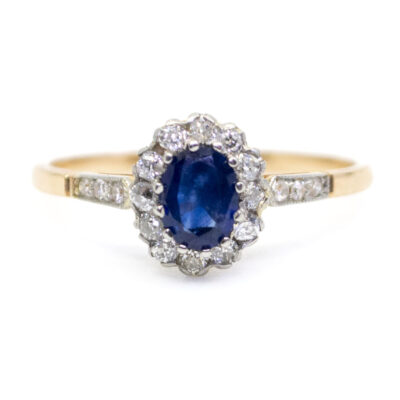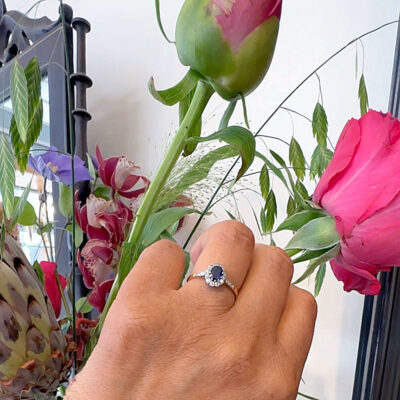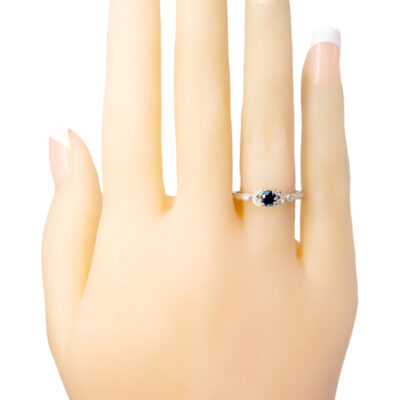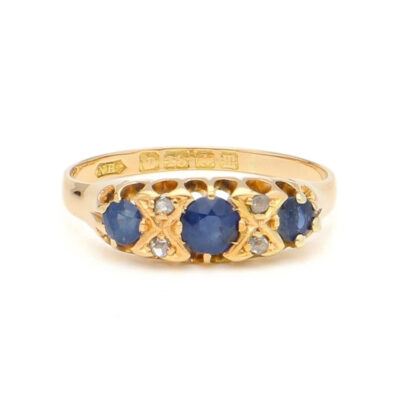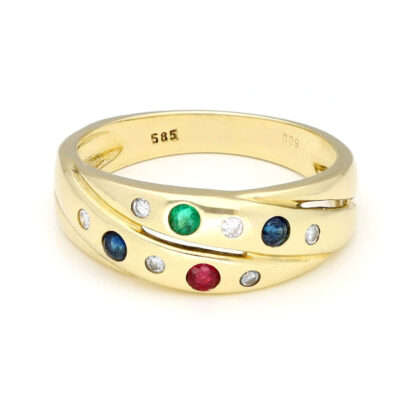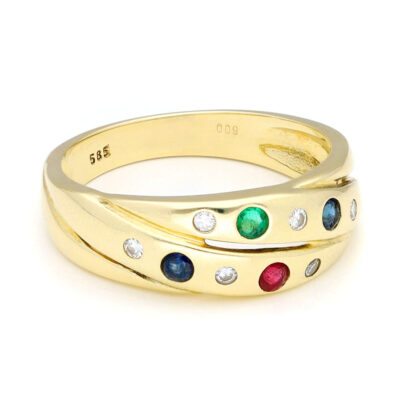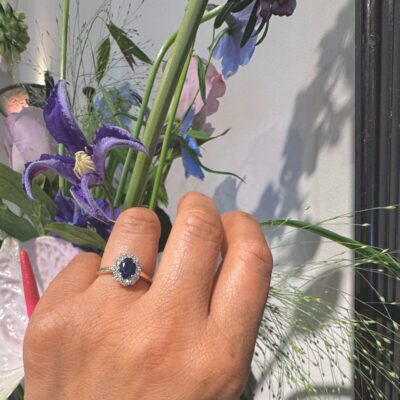This beautiful Edwardian-style halo ring is crafted in white 14k and features an oval-cut sapphire in its centre, estimated at 1.50ct. Surrounding this sapphire is a beautiful double halo of approximately 0.50ct single-cut diamonds.
Videos
Details: ±1.50ct Sapphire, double halo of ±0.50ct Single-cut diamonds, 14k Ring.
Design Era: New Victorian.
Size: 17.53 NL / 55.1 FR / 7¼ US / O UK, sizeable (Within reason. Contact seller for information).
Dimensions: H 0.6 x L 1.4 x W 1.8 cm.
Weight in grams: 4.
Condition: Very good condition – slightly used with small signs of wear.
Shipping and Pickup: This beautiful piece ships from our store located in the center of Amsterdam, The Netherlands. We offer both registered shipping and local pickup at our store. In the case of local pickup, any applicable shipping costs will be refunded.
About Us: Add some sparkle to your style with Binenbaum.com. We offer a stunning selection of antique and vintage jewelry that you won’t find anywhere else. From timeless rings and dazzling necklaces to unique brooches, we have something for every taste and occasion. Visit our website today and treat yourself to a piece of history.
| Design Era | |
|---|---|
| Design & Historical Context | The Victorian Era spanned Queen Victoria's rule of England from 1837 until 1901. During this time, a middle class began to emerge, sparking a demand for jewelry in the mass market, jewelry trends often reflected the tone of current events. The era is usually divided into several subsections: the Romantic Period from 1837 to 1861, the Grand Period from 1861 to 1880, and the Aesthetic Period from 1880 to 1901. During the Romantic Period jewelry also featured nature-inspired designs, similar to jewelry of the Georgian era. Frequently, these designs were delicately and intricately etched into gold. Lockets and brooches were popular in daytime jewelry during the early Victorian era, whereas colored gemstones and diamonds were worn during the evening. During the Grand Period jewelry , because the Grand or Mid-Victorian era corresponded with the death of Queen Victoria's husband, many jewelry pieces have solemn, somber designs. Known as mourning jewelry, the pieces feature heavy, dark stones. Jet, onyx, amethyst, and garnet are frequently found in jewelry from this period. Compared to previous periods, Mid-Victorian-era jewelry features highly creative, colorful designs using shells, mosaics and gemstones. During the Aesthetic period, jewelers used diamonds and feminine, bright gemstones such as sapphire, peridot, and spinel. Star and crescent designs as well as elaborate hat pins were also popular. Some scholars believe the aesthetic era began sooner, in 1875, and ended as early as 1890. |
| Key Materials | |
| Materials & Craftsmanship | Sapphire: The Gem of Wisdom and Royalty Sapphire, known for its stunning deep blue color, is a gemstone that embodies wisdom, loyalty, and nobility. This precious stone is a variety of the mineral corundum, and while blue is the most famous color, sapphires can also be found in a range of hues, including pink, yellow, green, and even colorless. Historically, sapphire has been revered across cultures for its association with the divine and the eternal. In ancient Persia, it was believed that the sky was painted blue by the reflection of sapphire stones. Throughout the ages, sapphire has been favored by royalty and clergy as a symbol of purity, virtue, and divine favor. Perhaps the most famous modern example is the sapphire engagement ring worn by Princess Diana and now by the Duchess of Cambridge. In jewelry, sapphire is celebrated for its beauty and durability, boasting a Mohs hardness of 9, second only to diamond. This makes sapphire an excellent choice for rings, necklaces, and earrings intended for everyday wear. The stone’s intense color and clarity are often highlighted by settings in white gold or platinum, though yellow gold can also enhance its warmth and depth. Sapphire is more than just a gemstone; it is a symbol of wisdom, fidelity, and nobility. Its rich history, combined with its remarkable durability and beauty, makes it a timeless and elegant choice for jewelry that signifies enduring love and commitment. Single-cut diamond: The Classic Sparkle of Timeless Elegance Single-cut diamonds are a classic and elegant choice in the world of fine jewelry, known for their understated yet captivating sparkle. Unlike modern brilliant-cut diamonds, which typically have 58 facets, single-cut diamonds have fewer facets—usually 17 or 18—resulting in a simpler, more traditional appearance. Historically, single-cut diamonds were among the earliest diamond cuts used in jewelry, dating back to the 14th century. This cut was popular in vintage and antique jewelry, especially during the Victorian and Edwardian eras. The fewer facets of a single-cut diamond create a subtle, soft brilliance, which adds a touch of old-world charm and sophistication to any piece. In modern jewelry, single-cut diamonds are often used as accent stones in pavé settings, vintage-inspired designs, and delicate pieces where a more refined sparkle is desired. Their simplicity makes them an excellent choice for adding a touch of elegance without overwhelming the overall design. Single-cut diamonds are more than just a gemstone choice; they are a nod to timeless beauty and classic craftsmanship. Their subtle sparkle and historical significance make them a perfect option for those who appreciate the charm of vintage and antique-inspired jewelry. 14k: The Durable Choice for Everyday Elegance 14k gold is a popular and practical choice in fine jewelry, known for its durability, affordability, and beautiful color. The 14k signifies that the gold is composed of 58.3% pure gold and 41.7% alloyed metals, such as copper, silver, nickel, or zinc. This combination results in a strong and resilient material that can withstand the rigors of daily wear, making it an ideal option for those seeking both beauty and durability. Historically, gold has always been a symbol of wealth and luxury, and 14k gold strikes a perfect balance between the rich appearance of gold and the strength needed for everyday use. Because of its lower gold content compared to 18k or 24k gold, 14k gold is more affordable, making it a popular choice for a wide range of jewelry pieces. In modern jewelry, 14k gold is appreciated for its versatility and variety. It is available in several colors, each achieved by mixing gold with different metals: Yellow Gold: A classic and timeless choice, 14k yellow gold has a warm, golden hue that complements most skin tones and is well-suited for both modern and traditional designs. White Gold: Created by alloying gold with white metals like nickel or palladium, 14k white gold has a sleek, silver-like appearance. It is often rhodium-plated for added shine and is a popular choice for engagement rings and other contemporary jewelry. Rose Gold: Achieved by mixing gold with copper, 14k rose gold has a soft, pinkish hue that has gained popularity for its romantic and vintage appeal. It is a favorite for those seeking a unique and stylish alternative to traditional gold colors. 14k gold is commonly used in a wide array of jewelry, including rings, necklaces, bracelets, earrings, and watches. Its durability makes it especially suitable for pieces that are worn daily, such as wedding bands and engagement rings, where the balance between strength and beauty is crucial. 14k gold is more than just a practical choice; it is a symbol of enduring style and everyday luxury. Its ability to retain the look of gold while offering greater resistance to scratches and dents makes 14k gold a versatile and timeless option for any jewelry collection. Whether in a simple band or an elaborate design, 14k gold offers a perfect blend of elegance and durability that can be enjoyed for years to come. |
| Size | |
| Dimensions | H 0.6 x L 1.4 x W 1.8 cm |
| Gender | |
| Weight (in grams) | 4 |
| Condition | Very good condition – slightly used with small signs of wear |
By following these tips, you can enjoy your precious jewelry for many years to come.
Related Products
-
Diamond Sapphire 14k Halo Ring 10832-6775
€ 1.995,00 VAT incl. (where applicable) -
Diamond Sapphire 14k Platinum Cluster Ring 17315-4977
€ 1.895,00 VAT incl. (where applicable) -
Sapphire Diamond 18k Ring 5072-4669
€ 1.795,00 VAT incl. (where applicable) -
Diamond Sapphire 18k Row Ring 16514-8860
€ 1.895,00 VAT incl. (where applicable) -
Sapphire Diamond 18k Cluster Ring 15164-8518
€ 2.295,00 VAT incl. (where applicable) -
Diamond Emerald Ruby Sapphire 14k Swirl Ring 17886-9327
€ 1.295,00 VAT incl. (where applicable) -
Diamond Sapphire 14k Cluster Ring 17965-9362
€ 1.995,00 VAT incl. (where applicable) -
Diamond Sapphire 18k Row Ring 17553-9241
€ 3.895,00 VAT incl. (where applicable)
- Home
- Collection
- Fine Jewelry
- Silver Jewelry
- Silverware
- Boxes
- Candlesticks
- Salt and pepper shakers
- Miniatures
- Salt cellars
- Spoon Set
- Condiments
- Frames
- Napkin Ring
- Spoon
- Oddities
- Cups
- Vases
- Cutlery
- Serving Spoon And Cake Server
- Candlesticks
- Baskets
- Hanukkiah
- Spice Tower
- Yad
- Tea Set
- Sugar Castor
- Napkin Rings
- Wine Bottle Coaster
- Wine Stopper
- Tea Pot
- Jugs
- Rattles
- Hip Flask
- Miscellaneous
- Rings 💍
- About
- Contact







